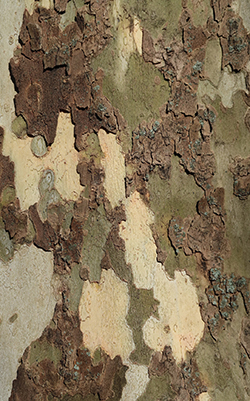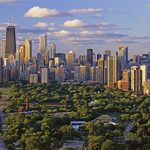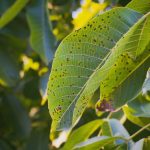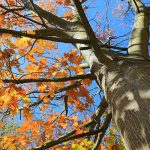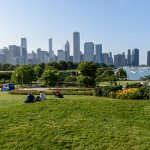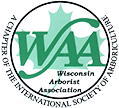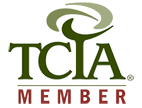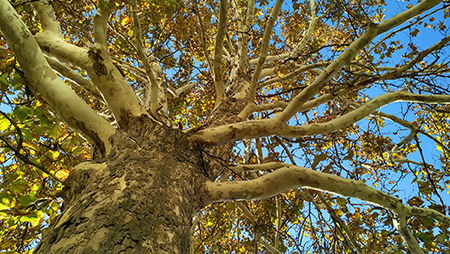
Sycamore trees are long-lived, giant-sized shade trees that grow well throughout Illinois when properly cared for
We have returned with our ongoing series on the native trees of the Chicago area to highlight sycamore trees throughout Illinois. Sycamore trees (Platanus sp.), also known as plane trees, are tall deciduous trees found throughout the Northern Hemisphere. The genus Platanus consists of 11 different tree species; four species referred to as sycamores that are native to North America and seven species referred to as plane trees that are found in Mexico and areas of Asia and Europe. Sycamore trees are most easily identified by their height, as they can reach up to 100 feet, and their flaky, irregular bark.
Of the 11 known species of sycamores, 8 of them are found in North America and 3 of them are native to the United States. The only sycamore tree that is found in the Chicago area is the American sycamore that can be found throughout the entire eastern half of the U.S. In this guide we will take a deeper look at sycamore trees, including their main characteristics, natural threats, and care tips to help you care for your sycamore trees. This guide will generally focus on the American sycamore that is native to the Chicago area, but also highlight other common species of sycamore trees.
Sycamore trees are often planted in yards and landscapes because their size makes them a great shade tree and they attract wildlife including many types of birds. Taking proper care of your sycamore trees will help them grow to their full potential and live for up to 200 years. At Hendricksen Tree Care, our professional arborists can provide tree care and maintenance services to keep your sycamore trees in good health. With our tree services, we can ensure proper fertilization and pruning, and provide diagnosis and treatment of insects and diseases that can harm your tree.
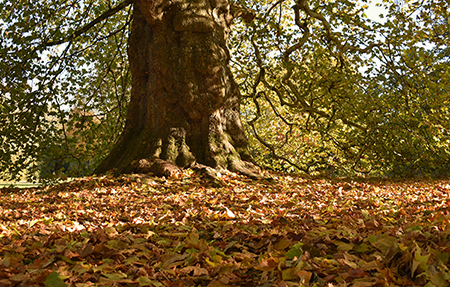
Sycamore trees can be a very long-lived species and get massive in size, such as this ancient Sycamore tree pictured above
Sycamore Tree Characteristics
Sycamore trees are tall, fast growing trees with dense canopies. These trees can grow up to around 100 feet in height and they can even reach a width of up to 70 feet. The most easily identifiable characteristics of sycamore trees are the flaky bark that is grayish brown and the multiple secondary trunks that form close to the ground. The leaves that form the dense canopies are three or five lobed leaves that look similar to maple leaves with toothed edges.
The following are the main characteristics of sycamore trees:
-

Flaky tree bark of a Sycamore tree
Height: In general, sycamore trees can range in height from 60 to 100 feet. It is also common for sycamores to exceed 100 feet in height.
- Leaves: Sycamore leaves look very similar to maple leaves with three to five broad lobes and toothed edges. They grow in an alternate pattern on the branch and they are 4-9 inches wide. These leaves have a leathery feel and are bright green in the summer, and they turn shades of gold and brown in the fall.
- Bark: The bark of sycamore trees is reddish brown or grayish brown in color and flaky. The irregular, plate-like scales easily peel off the tree and reveal the surface underneath which may be white, pale yellow, or green in color. The peeling bark causes the trunk and branches of sycamores to appear multi-colored. Sycamore trees typically shed their bark as they grow because the bark is rigid and does not have the elasticity to stretch and grow with the tree.
- Trunk and Branches: The main trunk of a sycamore tree can be very thick, and it often divides into several secondary trunks close to the ground. The branches spread from these secondary trunks to form an irregular, open canopy. Sycamore trunks are usually 5-7 feet in diameter but can get as thick as 13 feet in diameter.
- Flowers: Sycamores are monoecious which means male and female flowers will appear on the same plant, but they grow separately from each other. Both the male and female flowers appear in the spring as dense green balls that may appear slightly reddish or yellow. Male flowers wither and fall after dispersing their pollen while female flowers mature into seed bearing fruits.
- Fruit: The fruit of sycamore trees appear as brown, burr-like balls with clusters of seed-like fruits. The seeds are generally dispersed by the wind or animals, and they are light enough to float.
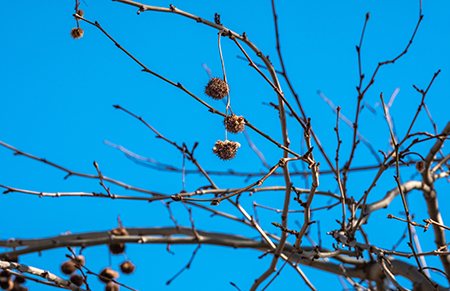
The round, burr-like seeds of the Sycamore tree
Species of Sycamore Trees
As mentioned above, the American sycamore is one of three sycamore trees native to the U.S., along with the California sycamore and Arizona sycamore. There are also several sycamore species native to Mexico and a few that can be found in Europe and Asia. The following are common species of sycamore trees:
- American Sycamore: The American sycamore (Platanus occidentalis) is the only sycamore tree native to the Chicago area. These sycamores routinely grow around 100 feet in height, and they are distinguished by their flaky, irregular plate-like bark.
- California Sycamore: The California sycamore (Platanus racemosa) is a tall sycamore found on the coast of California and Baha California. The bark of a California sycamore tends to be lighter in color than that of an American sycamore with patches of white, gray, beige, and pale brown.
- Arizona Sycamore: The Arizona sycamore (Platanus wrightii) is native to southern Arizona and New Mexico and northwestern regions of Mexico. These trees generally grow to around 80 feet in height and they are found in deserts and mountainous areas. The leaves of an Arizona sycamore are smaller than those of other sycamore trees and they have lightly colored, almost white bark.
- London Plane: The London plane (Platanus x acerifolia) is a hybrid sycamore tree that is planted in urban areas in London, New York City, and major cities in Australia. This tree is a hybrid of the oriental plane and American sycamore and it looks very similar to an American sycamore. London planes are planted in urban areas because they are much more resistant to pollutants than other sycamore trees.
- Oriental Plane: Oriental plane trees (Platanus orientalis) are large sycamore trees that can be found in southeastern Europe and throughout western Asia. They can grow to around 100 feet and they have a more spread out crown than other sycamores. These trees also have a long lifespan.
Natural Threats to Sycamore Trees
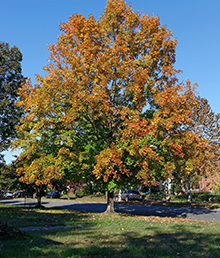
When kept healthy, Sycamore trees can have a beautiful golden orange color across their large canopy in the Fall time
Sycamore trees can live for hundreds of years and become massive in size if they can avoid problems with insects and disease. There are several diseases and insects that can cause problems for the various species of sycamore trees. The following are the most serious natural threats:
Diseases:
- Anthracnose: Anthracnose is a fungal disease that can cause damage to American sycamores, but other species like the London plane and oriental plane are much more resistant to this disease. This disease attacks the twigs, buds, shoots, and leaves, resulting in defoliation and cankers that can girdle and kill branches. While anthracnose can kill off branches and completely defoliate the tree, it typically will not kill an American sycamore unless the disease reoccurs over several years. Proper fertilization can help prevent anthracnose and effective pruning to remove dead or diseased branches can stop its spread.
- Powdery Mildew: Powdery mildew is a fungal disease that attacks leaves and twigs. In the early stages of this disease, white or gray patches appear on twigs and leaves and these patches can spread and form a powdery layer on the surface. Eventually the affected leaves will yellow and fall off. This disease typically attacks young shoots and leaves and can stunt new growth. If the powdery mildew is bad enough, the tree may be treated with fungicides.
- Bacterial Leaf Scorch: Bacterial leaf scorch is a disease caused by a bacteria pathogen that affects the xylem, or water carrying tubes, of the tree. This disease is commonly spread by insects that feed on xylem fluids. The leaves of affected trees will become dry and scorched and eventually die on the branch. The older leaves on a branch are affected first and the disease will move to the younger leaves. Bacterial leaf scorch can kill entire branches and even result in the removal of the tree. The only effective way to treat trees affected by this disease is to prune out the affected branches early.
Insects
- Sycamore Lace Bug: Sycamore lace bugs are small insects, about 1/8 of an inch in length, and they are dark colored with lacy patterns on their backs and wings. These bugs live under the bark of sycamore trees in the winter and lay eggs on the underside of the leaves in the spring. As the nymphs hatch, they feed on the sap from the leaves along with the adults. The leaf tissue will turn yellow at the feeding spots and the skins and waste materials these bugs leave behind can cover the leaves. Sycamore lace bugs do not cause serious damage, but they can stunt new growth.
- Sycamore Leaf Beetle: The sycamore leaf beetle is a beetle that feeds and mates on the leaves of American sycamore trees. The adults are only 3-4 millimeters in length, and they are brownish in color with a bumpy exoskeleton. Adult beetles and their larvae feed on the leaves which can lead to significant defoliation.
- Sycamore Scale: Sycamore scale insects are very tiny insects that are damaging to California sycamore trees. These insects are so small, about 1/16 of an inch, that it is hard to see them with the naked eye. Scale insects are yellow or orange in color and they leave yellow or whitish spots at their feeding sites. They also leave a waxy secretion behind on the leaves and bark. Sycamore scale feed on the leaves and bark which can cause the leaves to drop prematurely and the bark to become separated from the tree. In extreme cases, these insects can cause twigs and small branches to die and stunt the growth of the tree.
Sycamore Care Tips
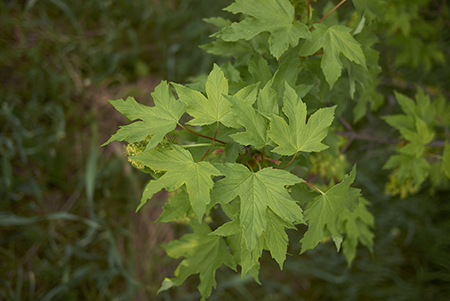
Healthy leaves of the Sycamore tree
With proper care and fertilization, sycamore trees can resist diseases and insects and live for more than a century. If you have sycamore trees on your property, the following care tips will help these trees grow and live to their full potential:
- Planting: Sycamore trees do best in moist, well-drained soil with plenty of sunlight. If you are planting a new sycamore tree, make sure you choose an area with plenty of sunlight and enough room for its expansive root system. There should be at least 12 feet between your sycamore and the nearest tree.
- Watering: Newly planted sycamore trees should be watered often for the first couple of years. You need to water these trees deeply to ensure that the water reaches the entire root system. Sycamore trees become more drought resistant as they develop and do not need to be watered as often after the first couple of years. However, you should give established sycamores a deep watering after if there has been no rain for a month.
- Mulching: Laying down a 2-3 inch layer of organic mulch out to the dripline will help retain moisture, discourage weeds, and insulate the soil. The mulch can be made from shredded bark, wood chips, or chopped leaves.
- Fertilization: New sycamore trees should be fertilized in the fall for the first few years. After they are established, they only need to be fertilized every other year.
Pruning: Sycamore trees should be pruned when they are young to maintain their structure and promote center leading branches. They should also be pruned in the winter during their formative years to remove dead, broken, and diseased branches and help preserve their shape. Tree pruning is a difficult and dangerous job for tall trees like sycamores which is why it is beneficial to call a professional for tree pruning.
Professional Tree Care Services for Sycamore Trees
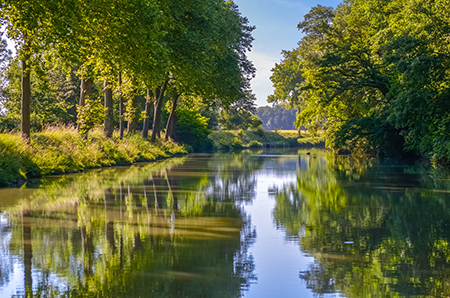
Sycamore trees along a river bank. Consider planting one of these large shade trees in your landscape today!
Sycamore trees provide shade and natural beauty to yards and landscapes with their dense canopies, majestic height, and their unique, multi-colored patched bark. The flowers and fruit will attract wildlife to your property and its bark and leaves will add much beauty to your landscape, especially during the fall. You must check your sycamore trees for signs of insect infestation or disease that can harm the aesthetic of the tree. Working with a professional arborist like Hendricksen Tree Care will ensure that your sycamore trees get the care they need to stay healthy and live a long life.
At Hendricksen Tree Care, we provide full tree care services for all types of trees to help avoid insects and diseases and ensure that they get the care and maintenance they need to grow to their full potential. Our arborists are ISA certified and can provide expert treatment, maintenance, and pruning to keep your trees healthy and vibrant. We proudly serve residential and commercial clients in the northwest Chicago suburbs including Wilmette, Palatine, Arlington Heights, Northbrook, Mount Prospect, Lake Bluff, Barrington, and the surrounding areas.
